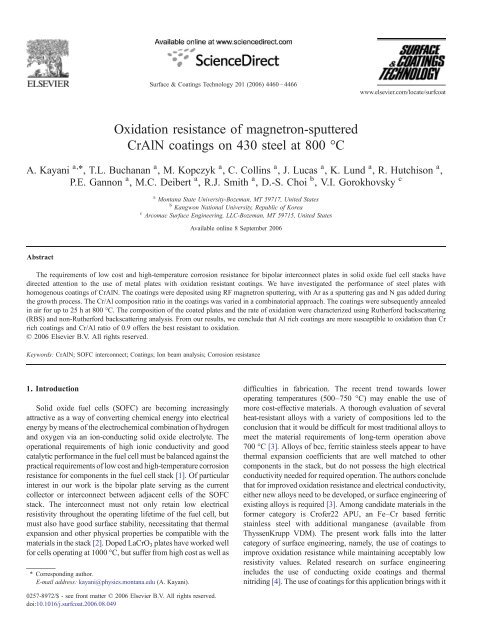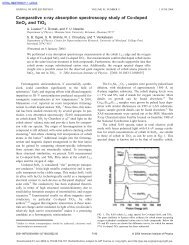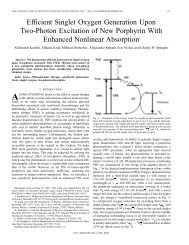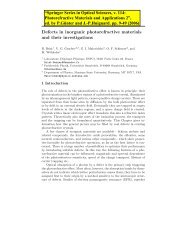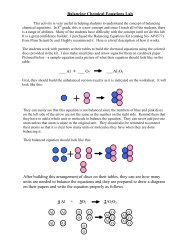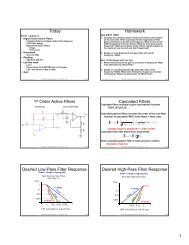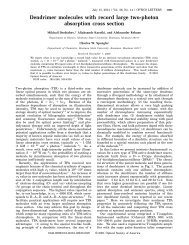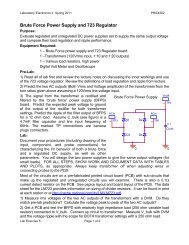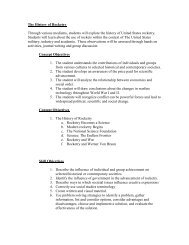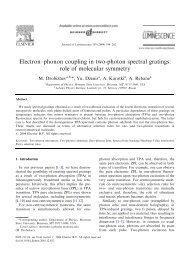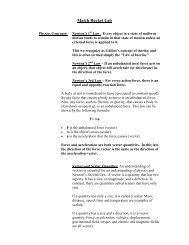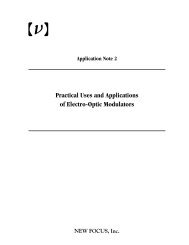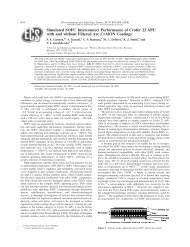Oxidation resistance of magnetron-sputtered CrAlN coatings on 430 ...
Oxidation resistance of magnetron-sputtered CrAlN coatings on 430 ...
Oxidation resistance of magnetron-sputtered CrAlN coatings on 430 ...
You also want an ePaper? Increase the reach of your titles
YUMPU automatically turns print PDFs into web optimized ePapers that Google loves.
Surface & Coatings Technology 201 (2006) 4460–4466<br />
www.elsevier.com/locate/surfcoat<br />
<str<strong>on</strong>g>Oxidati<strong>on</strong></str<strong>on</strong>g> <str<strong>on</strong>g>resistance</str<strong>on</strong>g> <str<strong>on</strong>g>of</str<strong>on</strong>g> <str<strong>on</strong>g>magnetr<strong>on</strong></str<strong>on</strong>g>-<str<strong>on</strong>g>sputtered</str<strong>on</strong>g><br />
<str<strong>on</strong>g>CrAlN</str<strong>on</strong>g> <str<strong>on</strong>g>coatings</str<strong>on</strong>g> <strong>on</strong> <strong>430</strong> steel at 800 °C<br />
A. Kayani a, ⁎ , T.L. Buchanan a , M. Kopczyk a , C. Collins a , J. Lucas a , K. Lund a , R. Hutchis<strong>on</strong> a ,<br />
P.E. Gann<strong>on</strong> a , M.C. Deibert a , R.J. Smith a , D.-S. Choi b , V.I. Gorokhovsky c<br />
a M<strong>on</strong>tana State University-Bozeman, MT 59717, United States<br />
b Kangw<strong>on</strong> Nati<strong>on</strong>al University, Republic <str<strong>on</strong>g>of</str<strong>on</strong>g> Korea<br />
c Arcomac Surface Engineering, LLC-Bozeman, MT 59715, United States<br />
Available <strong>on</strong>line 8 September 2006<br />
Abstract<br />
The requirements <str<strong>on</strong>g>of</str<strong>on</strong>g> low cost and high-temperature corrosi<strong>on</strong> <str<strong>on</strong>g>resistance</str<strong>on</strong>g> for bipolar interc<strong>on</strong>nect plates in solid oxide fuel cell stacks have<br />
directed attenti<strong>on</strong> to the use <str<strong>on</strong>g>of</str<strong>on</strong>g> metal plates with oxidati<strong>on</strong> resistant <str<strong>on</strong>g>coatings</str<strong>on</strong>g>. We have investigated the performance <str<strong>on</strong>g>of</str<strong>on</strong>g> steel plates with<br />
homogenous <str<strong>on</strong>g>coatings</str<strong>on</strong>g> <str<strong>on</strong>g>of</str<strong>on</strong>g> <str<strong>on</strong>g>CrAlN</str<strong>on</strong>g>. The <str<strong>on</strong>g>coatings</str<strong>on</strong>g> were deposited using RF <str<strong>on</strong>g>magnetr<strong>on</strong></str<strong>on</strong>g> sputtering, with Ar as a sputtering gas and N gas added during<br />
the growth process. The Cr/Al compositi<strong>on</strong> ratio in the <str<strong>on</strong>g>coatings</str<strong>on</strong>g> was varied in a combinatorial approach. The <str<strong>on</strong>g>coatings</str<strong>on</strong>g> were subsequently annealed<br />
in air for up to 25 h at 800 °C. The compositi<strong>on</strong> <str<strong>on</strong>g>of</str<strong>on</strong>g> the coated plates and the rate <str<strong>on</strong>g>of</str<strong>on</strong>g> oxidati<strong>on</strong> were characterized using Rutherford backscattering<br />
(RBS) and n<strong>on</strong>-Rutherford backscattering analysis. From our results, we c<strong>on</strong>clude that Al rich <str<strong>on</strong>g>coatings</str<strong>on</strong>g> are more susceptible to oxidati<strong>on</strong> than Cr<br />
rich <str<strong>on</strong>g>coatings</str<strong>on</strong>g> and Cr/Al ratio <str<strong>on</strong>g>of</str<strong>on</strong>g> 0.9 <str<strong>on</strong>g>of</str<strong>on</strong>g>fers the best resistant to oxidati<strong>on</strong>.<br />
© 2006 Elsevier B.V. All rights reserved.<br />
Keywords: <str<strong>on</strong>g>CrAlN</str<strong>on</strong>g>; SOFC interc<strong>on</strong>nect; Coatings; I<strong>on</strong> beam analysis; Corrosi<strong>on</strong> <str<strong>on</strong>g>resistance</str<strong>on</strong>g><br />
1. Introducti<strong>on</strong><br />
Solid oxide fuel cells (SOFC) are becoming increasingly<br />
attractive as a way <str<strong>on</strong>g>of</str<strong>on</strong>g> c<strong>on</strong>verting chemical energy into electrical<br />
energy by means <str<strong>on</strong>g>of</str<strong>on</strong>g> the electrochemical combinati<strong>on</strong> <str<strong>on</strong>g>of</str<strong>on</strong>g> hydrogen<br />
and oxygen via an i<strong>on</strong>-c<strong>on</strong>ducting solid oxide electrolyte. The<br />
operati<strong>on</strong>al requirements <str<strong>on</strong>g>of</str<strong>on</strong>g> high i<strong>on</strong>ic c<strong>on</strong>ductivity and good<br />
catalytic performance in the fuel cell must be balanced against the<br />
practical requirements <str<strong>on</strong>g>of</str<strong>on</strong>g> low cost and high-temperature corrosi<strong>on</strong><br />
<str<strong>on</strong>g>resistance</str<strong>on</strong>g> for comp<strong>on</strong>ents in the fuel cell stack [1]. Ofparticular<br />
interest in our work is the bipolar plate serving as the current<br />
collector or interc<strong>on</strong>nect between adjacent cells <str<strong>on</strong>g>of</str<strong>on</strong>g> the SOFC<br />
stack. The interc<strong>on</strong>nect must not <strong>on</strong>ly retain low electrical<br />
resistivity throughout the operating lifetime <str<strong>on</strong>g>of</str<strong>on</strong>g> the fuel cell, but<br />
must also have good surface stability, necessitating that thermal<br />
expansi<strong>on</strong> and other physical properties be compatible with the<br />
materials in the stack [2]. Doped LaCrO 3 plates have worked well<br />
for cells operating at 1000 °C, but suffer from high cost as well as<br />
⁎ Corresp<strong>on</strong>ding author.<br />
E-mail address: kayani@physics.m<strong>on</strong>tana.edu (A. Kayani).<br />
difficulties in fabricati<strong>on</strong>. The recent trend towards lower<br />
operating temperatures (500–750 °C) may enable the use <str<strong>on</strong>g>of</str<strong>on</strong>g><br />
more cost-effective materials. A thorough evaluati<strong>on</strong> <str<strong>on</strong>g>of</str<strong>on</strong>g> several<br />
heat-resistant alloys with a variety <str<strong>on</strong>g>of</str<strong>on</strong>g> compositi<strong>on</strong>s led to the<br />
c<strong>on</strong>clusi<strong>on</strong> that it would be difficult for most traditi<strong>on</strong>al alloys to<br />
meet the material requirements <str<strong>on</strong>g>of</str<strong>on</strong>g> l<strong>on</strong>g-term operati<strong>on</strong> above<br />
700 °C [3]. Alloys <str<strong>on</strong>g>of</str<strong>on</strong>g> bcc, ferritic stainless steels appear to have<br />
thermal expansi<strong>on</strong> coefficients that are well matched to other<br />
comp<strong>on</strong>ents in the stack, but do not possess the high electrical<br />
c<strong>on</strong>ductivity needed for required operati<strong>on</strong>. The authors c<strong>on</strong>clude<br />
that for improved oxidati<strong>on</strong> <str<strong>on</strong>g>resistance</str<strong>on</strong>g> and electrical c<strong>on</strong>ductivity,<br />
either new alloys need to be developed, or surface engineering <str<strong>on</strong>g>of</str<strong>on</strong>g><br />
existing alloys is required [3]. Am<strong>on</strong>g candidate materials in the<br />
former category is Cr<str<strong>on</strong>g>of</str<strong>on</strong>g>er22 APU, an Fe–Cr based ferritic<br />
stainless steel with additi<strong>on</strong>al manganese (available from<br />
ThyssenKrupp VDM). The present work falls into the latter<br />
category <str<strong>on</strong>g>of</str<strong>on</strong>g> surface engineering, namely, the use <str<strong>on</strong>g>of</str<strong>on</strong>g> <str<strong>on</strong>g>coatings</str<strong>on</strong>g> to<br />
improve oxidati<strong>on</strong> <str<strong>on</strong>g>resistance</str<strong>on</strong>g> while maintaining acceptably low<br />
resistivity values. Related research <strong>on</strong> surface engineering<br />
includes the use <str<strong>on</strong>g>of</str<strong>on</strong>g> c<strong>on</strong>ducting oxide <str<strong>on</strong>g>coatings</str<strong>on</strong>g> and thermal<br />
nitriding [4]. The use <str<strong>on</strong>g>of</str<strong>on</strong>g> <str<strong>on</strong>g>coatings</str<strong>on</strong>g> for this applicati<strong>on</strong> brings with it<br />
0257-8972/$ - see fr<strong>on</strong>t matter © 2006 Elsevier B.V. All rights reserved.<br />
doi:10.1016/j.surfcoat.2006.08.049
A. Kayani et al. / Surface & Coatings Technology 201 (2006) 4460–4466<br />
4461<br />
an additi<strong>on</strong>al set <str<strong>on</strong>g>of</str<strong>on</strong>g> problems, namely, guaranteeing the integrity<br />
<str<strong>on</strong>g>of</str<strong>on</strong>g> the coating with respect to adhesi<strong>on</strong>, wear <str<strong>on</strong>g>resistance</str<strong>on</strong>g>, and<br />
detrimental effects associated with interdiffusi<strong>on</strong> between coating<br />
and substrate material. On the other hand, using <str<strong>on</strong>g>coatings</str<strong>on</strong>g> enables<br />
the use <str<strong>on</strong>g>of</str<strong>on</strong>g> inexpensive alloys that would otherwise be ruled out<br />
because <str<strong>on</strong>g>of</str<strong>on</strong>g> their poor oxidati<strong>on</strong> <str<strong>on</strong>g>resistance</str<strong>on</strong>g>.<br />
The use <str<strong>on</strong>g>of</str<strong>on</strong>g> <str<strong>on</strong>g>coatings</str<strong>on</strong>g> to improve oxidati<strong>on</strong> <str<strong>on</strong>g>resistance</str<strong>on</strong>g> <strong>on</strong> metal<br />
alloys has been known for many years. We selected the Cr–Al–<br />
N system for this study because it not <strong>on</strong>ly <str<strong>on</strong>g>of</str<strong>on</strong>g>fers oxidati<strong>on</strong><br />
<str<strong>on</strong>g>resistance</str<strong>on</strong>g> at temperatures up to 900 °C [5,6], but also provides a<br />
high wear <str<strong>on</strong>g>resistance</str<strong>on</strong>g> that is typical <str<strong>on</strong>g>of</str<strong>on</strong>g> many metal nitrides [7].<br />
For our previous study, we used multilayer and nanolayer<br />
structures, c<strong>on</strong>sisting <str<strong>on</strong>g>of</str<strong>on</strong>g> AlN and CrN, to study the affect <str<strong>on</strong>g>of</str<strong>on</strong>g> a<br />
layered structure and individual layer thickness <strong>on</strong> the oxidati<strong>on</strong><br />
kinetics for the coating [8,9]. In our present work we use<br />
homogeneous <str<strong>on</strong>g>CrAlN</str<strong>on</strong>g> <str<strong>on</strong>g>coatings</str<strong>on</strong>g>, deposited by <str<strong>on</strong>g>magnetr<strong>on</strong></str<strong>on</strong>g> sputtering,<br />
to study the affect <str<strong>on</strong>g>of</str<strong>on</strong>g> the Cr/Al ratio <strong>on</strong> oxidati<strong>on</strong> kinetics.<br />
Chromium nitride is a good oxidati<strong>on</strong> resistant material with<br />
anti-corrosive properties. Its uses include applicati<strong>on</strong>s in metal<br />
forming and plastic molding [10,11]. It is presently known that<br />
exposing CrN to oxygen at elevated temperatures leads<br />
eventually to loss <str<strong>on</strong>g>of</str<strong>on</strong>g> nitrogen and the formati<strong>on</strong> <str<strong>on</strong>g>of</str<strong>on</strong>g> Cr 2 O 3 [12]<br />
(which is a semic<strong>on</strong>ductor with a sufficiently low resistivity for<br />
use in interc<strong>on</strong>nect applicati<strong>on</strong>s at an operating temperature <str<strong>on</strong>g>of</str<strong>on</strong>g><br />
800 °C [13]). The oxidati<strong>on</strong> <str<strong>on</strong>g>of</str<strong>on</strong>g> AlN leads to the formati<strong>on</strong> <str<strong>on</strong>g>of</str<strong>on</strong>g><br />
Al 2 O 3 (alumina) which has an unacceptably low c<strong>on</strong>ductivity<br />
for use as an interc<strong>on</strong>nect material, yet alumina is known to be a<br />
good oxidati<strong>on</strong>-resistant barrier. In our study, using an RF and<br />
DC <str<strong>on</strong>g>magnetr<strong>on</strong></str<strong>on</strong>g> sputtering technique, we deposited <str<strong>on</strong>g>coatings</str<strong>on</strong>g> <str<strong>on</strong>g>of</str<strong>on</strong>g><br />
varying Cr/Al ratios <strong>on</strong>to a <strong>430</strong> stainless-steel plate sample<br />
substrate, the details <str<strong>on</strong>g>of</str<strong>on</strong>g> which will be addressed later.<br />
Depositi<strong>on</strong> <str<strong>on</strong>g>of</str<strong>on</strong>g> <str<strong>on</strong>g>coatings</str<strong>on</strong>g> using <str<strong>on</strong>g>magnetr<strong>on</strong></str<strong>on</strong>g> sputtering has many<br />
advantages. It is a low pressure sputtering process <str<strong>on</strong>g>of</str<strong>on</strong>g>fering a great<br />
deal <str<strong>on</strong>g>of</str<strong>on</strong>g> c<strong>on</strong>trol <str<strong>on</strong>g>of</str<strong>on</strong>g> the deposited i<strong>on</strong> flux species. At sputter<br />
depositi<strong>on</strong> pressures below 0.13 Pa we have a collisi<strong>on</strong>less<br />
process, and fast neutral particles start to play an important role in<br />
film growth. Magnetr<strong>on</strong> acti<strong>on</strong> occurs when the magnetic field<br />
and electric fields are normal to each other. Therefore the majority<br />
<str<strong>on</strong>g>of</str<strong>on</strong>g> i<strong>on</strong>izati<strong>on</strong> occurs in the center <str<strong>on</strong>g>of</str<strong>on</strong>g> an electr<strong>on</strong> cloud. The i<strong>on</strong>s<br />
formed are instantly attracted to the negatively biased target where<br />
they collide with its surface, causing surface atoms from the target<br />
material to be ejected (<str<strong>on</strong>g>sputtered</str<strong>on</strong>g>). Under the influence <str<strong>on</strong>g>of</str<strong>on</strong>g> the<br />
electric field present, electr<strong>on</strong>s are not allowed to move freely, so<br />
very few <str<strong>on</strong>g>of</str<strong>on</strong>g> them strike the substrate. The target <strong>on</strong> the other hand<br />
comes under fierce i<strong>on</strong> bombardment, particularly where most <str<strong>on</strong>g>of</str<strong>on</strong>g><br />
the i<strong>on</strong>s are produced. This acti<strong>on</strong> causes localized heating <str<strong>on</strong>g>of</str<strong>on</strong>g> the<br />
target material, which requires cooling.<br />
There are two types <str<strong>on</strong>g>of</str<strong>on</strong>g> <str<strong>on</strong>g>magnetr<strong>on</strong></str<strong>on</strong>g>s, balanced and unbalanced.<br />
In a balanced <str<strong>on</strong>g>magnetr<strong>on</strong></str<strong>on</strong>g>, the magnetic field <str<strong>on</strong>g>of</str<strong>on</strong>g> both the core and<br />
outer magnets are balanced with each other resulting in nearly all<br />
field lines in the magnetic trap to form closed loops between the<br />
poles <str<strong>on</strong>g>of</str<strong>on</strong>g> the magnet. In the cathode area, there is created a wide<br />
regi<strong>on</strong> c<strong>on</strong>taining a str<strong>on</strong>g magnetic field with field lines almost<br />
parallel to the target surface. In c<strong>on</strong>trast, the unbalanced<br />
<str<strong>on</strong>g>magnetr<strong>on</strong></str<strong>on</strong>g> has an imbalance between the magnetic fields <str<strong>on</strong>g>of</str<strong>on</strong>g> the<br />
outer and core magnets. For this particular study balanced<br />
<str<strong>on</strong>g>magnetr<strong>on</strong></str<strong>on</strong>g> heads were used to deposit <str<strong>on</strong>g>CrAlN</str<strong>on</strong>g> <str<strong>on</strong>g>coatings</str<strong>on</strong>g>. For<br />
analysis <str<strong>on</strong>g>of</str<strong>on</strong>g> sample elemental compositi<strong>on</strong> and oxidati<strong>on</strong><br />
<str<strong>on</strong>g>resistance</str<strong>on</strong>g>, Rutherford backscattering spectroscopy (RBS) and<br />
n<strong>on</strong>-Rutherford scattering were used. The films were annealed at<br />
800 °C in air for up to 25 h, and subsequently analyzed.<br />
2. Experimental procedure<br />
For this initial study, we used a <strong>430</strong> steel plate as the substrate,<br />
<str<strong>on</strong>g>of</str<strong>on</strong>g> dimensi<strong>on</strong>s 15.2×10.6 cm. An already polished stainless-steel<br />
plate was purchased from a local hardware store. This material is<br />
sold for use as a heat shield and its finishing process is termed<br />
“bright-annealed”. Sample coup<strong>on</strong>s <str<strong>on</strong>g>of</str<strong>on</strong>g> dimensi<strong>on</strong> 1×2 cm were<br />
laser cut from the steel plate in such a way that these coup<strong>on</strong>s were<br />
left attached to the plate with a small tab. Sputter coating was<br />
carried out at the M<strong>on</strong>tana Micr<str<strong>on</strong>g>of</str<strong>on</strong>g>abricati<strong>on</strong> Facility at M<strong>on</strong>tana<br />
State University. This chamber provided by Angstrom Engineering<br />
is fitted with three water-cooled balanced <str<strong>on</strong>g>magnetr<strong>on</strong></str<strong>on</strong>g> sputter<br />
heads mounted 120° apart <strong>on</strong> the horiz<strong>on</strong>tal plane and at an angle<br />
<str<strong>on</strong>g>of</str<strong>on</strong>g> 30° from the normal from the copper sample holder. Each head<br />
has a shutter attached for soaking purposes. The sample holder is a<br />
circular disk 15.3 cm in diameter which can be rotated. The<br />
sample holder is inserted into the sputtering chamber through a<br />
load lock. The substrate to sputter-target distance was 18 cm.<br />
Ultra high vacuum is created inside the sputtering chamber by a<br />
cryogenic pump. Gases used in reactive depositi<strong>on</strong> and for<br />
sputtering purposes are introduced into the chamber by separate<br />
precisi<strong>on</strong> mass flow c<strong>on</strong>trollers.<br />
Chromium and aluminum metal targets were used to deposit<br />
<str<strong>on</strong>g>coatings</str<strong>on</strong>g> <strong>on</strong>to our stainless-steel sample plate at room temperature.<br />
The chromium target used an RF power source set at 125 W.<br />
For the aluminum target, we chose a DC power source set to<br />
216 W. DC power was chosen for the aluminum target because the<br />
sputtering rate <str<strong>on</strong>g>of</str<strong>on</strong>g> aluminum is low compared to that for<br />
chromium. 10 sccm <str<strong>on</strong>g>of</str<strong>on</strong>g> arg<strong>on</strong> sputtering gas and 10 sccm nitrogen<br />
reactive gas were introduced into the chamber via separate mass<br />
flow c<strong>on</strong>trollers. Gas lines were evacuated for 24 h prior to sputter<br />
depositi<strong>on</strong> to minimize the c<strong>on</strong>taminati<strong>on</strong> in the gas lines. The<br />
sputtering chamber was cryogenically pumped for 24 h, achieving<br />
a base pressure in the range <str<strong>on</strong>g>of</str<strong>on</strong>g> 1.3×10 −6 Pa. The working<br />
pressure after introducti<strong>on</strong> <str<strong>on</strong>g>of</str<strong>on</strong>g> the Ar and N gases, was 0.68 Pa.<br />
Both sources were soaked for 15 min before beginning<br />
depositi<strong>on</strong>. Depositi<strong>on</strong> time was 4 h. A different Cr/Al ratio in<br />
the coating <strong>on</strong> the sample coup<strong>on</strong>s was obtained depending up<strong>on</strong><br />
their respective placement in the rectangular sample plate with<br />
respect to the Cr and Al gun positi<strong>on</strong>s as shown in Fig. 1.<br />
Fig. 1. Sample positi<strong>on</strong>s <strong>on</strong> the stainless steel substrate rectangular plate.
4462 A. Kayani et al. / Surface & Coatings Technology 201 (2006) 4460–4466<br />
<str<strong>on</strong>g>Oxidati<strong>on</strong></str<strong>on</strong>g> <str<strong>on</strong>g>of</str<strong>on</strong>g> the sample coup<strong>on</strong>s was carried out using a<br />
temperature c<strong>on</strong>trolled standard box furnace operated in air,<br />
with no additi<strong>on</strong>al features to c<strong>on</strong>trol humidity or air flow rate.<br />
Samples were placed horiz<strong>on</strong>tally <strong>on</strong> a ceramic holder with the<br />
coated face upwards at the center <str<strong>on</strong>g>of</str<strong>on</strong>g> the furnace. The oven<br />
temperature was c<strong>on</strong>trolled electr<strong>on</strong>ically and was ramped to<br />
800 °C at the rate <str<strong>on</strong>g>of</str<strong>on</strong>g> 3 °C/min. Soak times were incremented to<br />
give total oxidati<strong>on</strong> periods <str<strong>on</strong>g>of</str<strong>on</strong>g> 1, 4, 9, 16, and 25 h. After each<br />
increment <str<strong>on</strong>g>of</str<strong>on</strong>g> oxidati<strong>on</strong> time, the oven was cooled to ambient<br />
temperature over a period <str<strong>on</strong>g>of</str<strong>on</strong>g> 30 min. The samples were<br />
removed and placed in a vacuum chamber for i<strong>on</strong> beam<br />
analysis. Measurements are still in progress to determine the<br />
Area Specific Resistance (ASR) in ohm-cm 2 , using standard 4-<br />
point probe procedures with Pt paste electrodes <strong>on</strong> pre-oxidized<br />
samples for extended periods <str<strong>on</strong>g>of</str<strong>on</strong>g> time.<br />
3. Results and discussi<strong>on</strong><br />
Fig. 1 shows the coup<strong>on</strong> sample positi<strong>on</strong>s <strong>on</strong> the rectangular<br />
steel plate. For this initial study, five coup<strong>on</strong>s were analyzed,<br />
<strong>on</strong>e from each corner plus the <strong>on</strong>e in the center <str<strong>on</strong>g>of</str<strong>on</strong>g> the plate.<br />
These samples were labeled A2, A10, C2, C10 and AC3. The<br />
goal was to determine which <str<strong>on</strong>g>of</str<strong>on</strong>g> these samples dem<strong>on</strong>strates the<br />
best oxidati<strong>on</strong> <str<strong>on</strong>g>resistance</str<strong>on</strong>g> plus retains enough nitrogen after 25 h<br />
<str<strong>on</strong>g>of</str<strong>on</strong>g> heating and acts as a diffusi<strong>on</strong> barrier for the heavier elements<br />
moving from the substrate into the bulk <str<strong>on</strong>g>of</str<strong>on</strong>g> the coating. The<br />
subsequent step would be to choose and analyze other samples<br />
from the plate which lie close to the better <str<strong>on</strong>g>of</str<strong>on</strong>g> the first five.<br />
I<strong>on</strong> beam analysis <str<strong>on</strong>g>of</str<strong>on</strong>g> these samples was performed using a<br />
2 MV single-ended Van de Graaff accelerator at the I<strong>on</strong> beams<br />
lab facilities at M<strong>on</strong>tana State University (MSU) in Bozeman,<br />
MT. Rutherford backscattering spectra (RBS) were recorded<br />
using 1.5 MeV beams <str<strong>on</strong>g>of</str<strong>on</strong>g> He + and H + i<strong>on</strong>s, incident normal to<br />
the sample surface. Backscattered i<strong>on</strong>s were collected using a<br />
silic<strong>on</strong> surface barrier detector at a scattering angle <str<strong>on</strong>g>of</str<strong>on</strong>g> 165°, with<br />
an exit angle <str<strong>on</strong>g>of</str<strong>on</strong>g> 15° as measured with respect to the sample's<br />
surface normal. RBS spectra were collected for the as-deposited<br />
samples before heating as well as after successive oxidati<strong>on</strong><br />
periods <str<strong>on</strong>g>of</str<strong>on</strong>g> heating at 800 °C for heating times totaling 1, 4, 9, 16<br />
and 25 h. Since the samples were removed from the oven after<br />
each oxidati<strong>on</strong> period for i<strong>on</strong> beam analysis, they were thereby<br />
subjected to some thermal cycling, which may have affected the<br />
<str<strong>on</strong>g>coatings</str<strong>on</strong>g>. Compositi<strong>on</strong> pr<str<strong>on</strong>g>of</str<strong>on</strong>g>iles for the as-deposited samples<br />
(before oxidati<strong>on</strong>) were generated using SIMNRA computer<br />
simulati<strong>on</strong>s <str<strong>on</strong>g>of</str<strong>on</strong>g> the spectra as the basis for elemental compositi<strong>on</strong><br />
percentages [14]. The elemental c<strong>on</strong>centrati<strong>on</strong>s for samples A2,<br />
A10, C2, C10 and AC3 are listed in Table 1. Rutherford<br />
backscattering is particularly useful for obtaining c<strong>on</strong>centrati<strong>on</strong><br />
Table 1<br />
Survey <str<strong>on</strong>g>of</str<strong>on</strong>g> as deposited coating compositi<strong>on</strong>s<br />
Sample Cr % Al % N % Thickness (nm) Thickness (10 15 atoms/cm 2 )<br />
A2 4.5 38 57.5 722 8500<br />
AC3 15 28 57 552 6500<br />
A10 10.5 30 59.5 382 4500<br />
C2 19 21 60 552 6500<br />
C10 31 11 58 493 5800<br />
depth pr<str<strong>on</strong>g>of</str<strong>on</strong>g>iles for the heavier elements in the coating. However<br />
it is somewhat limited in detecting light elements such as O and<br />
N due to the quadratic dependence <str<strong>on</strong>g>of</str<strong>on</strong>g> the Rutherford cross<br />
secti<strong>on</strong> <strong>on</strong> the atomic number <str<strong>on</strong>g>of</str<strong>on</strong>g> the target atom. Therefore, a<br />
1.5 MeV H + beam was used to take advantage <str<strong>on</strong>g>of</str<strong>on</strong>g> the n<strong>on</strong>-<br />
Rutherford enhancement in the cross secti<strong>on</strong> <str<strong>on</strong>g>of</str<strong>on</strong>g> O and N at this<br />
energy. The set <str<strong>on</strong>g>of</str<strong>on</strong>g> target compositi<strong>on</strong> pr<str<strong>on</strong>g>of</str<strong>on</strong>g>ile parameters in the<br />
SIMNRA program was adjusted until a single set <str<strong>on</strong>g>of</str<strong>on</strong>g> parameters<br />
accurately simulated both the He + and H + RBS spectra. In some<br />
cases there is a rapid decrease in N c<strong>on</strong>tent following the initial<br />
<strong>on</strong>e-hour heat treatment. We attribute this decrease to several<br />
mechanisms: transformati<strong>on</strong> <str<strong>on</strong>g>of</str<strong>on</strong>g> CrN to Cr 2 N [13,15], transformati<strong>on</strong><br />
<str<strong>on</strong>g>of</str<strong>on</strong>g> AlN to Al 2 O 3 , and loss <str<strong>on</strong>g>of</str<strong>on</strong>g> N to the vacuum. We<br />
attribute the gradual loss <str<strong>on</strong>g>of</str<strong>on</strong>g> N during subsequent annealing to<br />
the transformati<strong>on</strong> <str<strong>on</strong>g>of</str<strong>on</strong>g> Cr 2 NtoCr 2 O 3 . The total as-deposited N<br />
c<strong>on</strong>tent varies from sample to sample due to the varied Cr/Al<br />
ratios obtained during the coating process. The variati<strong>on</strong> in the<br />
nitrogen c<strong>on</strong>tent is relatively small and can be taken as c<strong>on</strong>stant<br />
(see Table 1) for all <str<strong>on</strong>g>of</str<strong>on</strong>g> the samples, and therefore we will<br />
c<strong>on</strong>sider the Cr/Al ratio as the important parameter for the<br />
oxidati<strong>on</strong> properties <str<strong>on</strong>g>of</str<strong>on</strong>g> each sample.<br />
A depth scale <str<strong>on</strong>g>of</str<strong>on</strong>g> 10 15 atoms/cm 2 is characteristic <str<strong>on</strong>g>of</str<strong>on</strong>g> RBS<br />
analysis which describes the number <str<strong>on</strong>g>of</str<strong>on</strong>g> target atoms visible to<br />
the incident i<strong>on</strong> beam. If sample densities are known, this<br />
parameter is readily c<strong>on</strong>vertible to a linear depth scale. Since we<br />
had no prior knowledge <str<strong>on</strong>g>of</str<strong>on</strong>g> the densities <str<strong>on</strong>g>of</str<strong>on</strong>g> the as-deposited<br />
<str<strong>on</strong>g>coatings</str<strong>on</strong>g>, the average atomic density <str<strong>on</strong>g>of</str<strong>on</strong>g> cubic CrN and<br />
hexag<strong>on</strong>al AlN (1.2×10 23 atoms/cm 3 ) was used to establish<br />
that 1000×10 15 atoms/cm 3 corresp<strong>on</strong>ds to a depth <str<strong>on</strong>g>of</str<strong>on</strong>g> 85 nm.<br />
Based up<strong>on</strong> this quantity, the thickness <str<strong>on</strong>g>of</str<strong>on</strong>g> each coating was<br />
calculated and is listed in Table 1.<br />
The thickness and Cr/Al ratios <str<strong>on</strong>g>of</str<strong>on</strong>g> the coating for each sample<br />
varied due to their respective positi<strong>on</strong>s relative to the Cr and Al<br />
sputtering guns. The <str<strong>on</strong>g>coatings</str<strong>on</strong>g> in the five samples analyzed,<br />
dem<strong>on</strong>strate greatly varying characteristics when subjected to the<br />
same high-temperature oxidizing periods. In the as-deposited<br />
(n<strong>on</strong>-heated) coating, oxygen is not present and each c<strong>on</strong>tains<br />
nitrogen as expected from the envir<strong>on</strong>ment <str<strong>on</strong>g>of</str<strong>on</strong>g> the sputtering<br />
chamber present during the growth process. One <str<strong>on</strong>g>of</str<strong>on</strong>g> the desirable<br />
characteristics we wished to find is that some nitrogen is retained<br />
by the coating after the oxidati<strong>on</strong> process, which indicates<br />
improved oxidati<strong>on</strong> <str<strong>on</strong>g>resistance</str<strong>on</strong>g>. The final thickness <str<strong>on</strong>g>of</str<strong>on</strong>g> these<br />
<str<strong>on</strong>g>coatings</str<strong>on</strong>g> increases with the oxidati<strong>on</strong> process because <str<strong>on</strong>g>of</str<strong>on</strong>g> the<br />
transformati<strong>on</strong> <str<strong>on</strong>g>of</str<strong>on</strong>g> AlN to Al 2 O 3 and CrN to Cr 2 O 3 . We expect the<br />
dominant phases in the as deposited <str<strong>on</strong>g>coatings</str<strong>on</strong>g> to be AlN, CrN, and<br />
Cr 1−x Al x N, as reported in the literature [16].<br />
We first address the results for sample AC3 shown in the left<br />
column <str<strong>on</strong>g>of</str<strong>on</strong>g> Fig. 2. During the heating process at 800 °C, nitrogen is<br />
gradually replaced by oxygen. However, after 25 h <str<strong>on</strong>g>of</str<strong>on</strong>g> oxidati<strong>on</strong>,<br />
nitrogen is still present in the coating. In the near surface regi<strong>on</strong>,<br />
however nitrogen was completely replaced by oxygen. Furthermore,<br />
oxygen diffused through the coating, reaching the coating–<br />
substrate interface. We also observe that after <strong>on</strong>ly 25 h <str<strong>on</strong>g>of</str<strong>on</strong>g> heating,<br />
Fe begins to diffuse into the coating. The diffusi<strong>on</strong> depth <str<strong>on</strong>g>of</str<strong>on</strong>g> Fe<br />
from the substrate interface into the coating is about 80–90 nm.<br />
We expect further Fe diffusi<strong>on</strong> into the coating if the sample is<br />
subjected to subsequent extended periods <str<strong>on</strong>g>of</str<strong>on</strong>g> heating.
A. Kayani et al. / Surface & Coatings Technology 201 (2006) 4460–4466<br />
4463<br />
Fig. 2. Compositi<strong>on</strong> pr<str<strong>on</strong>g>of</str<strong>on</strong>g>ile evoluti<strong>on</strong> with annealing time for the samples AC3 (left column) and A2 (right column).<br />
In the coating <str<strong>on</strong>g>of</str<strong>on</strong>g> sample A2, nitrogen is completely replaced<br />
by oxygen after <strong>on</strong>ly 1 h <str<strong>on</strong>g>of</str<strong>on</strong>g> heating at 800 °C, as can be seen in<br />
Fig. 2, right column. No diffusi<strong>on</strong> <str<strong>on</strong>g>of</str<strong>on</strong>g> Fe or any heavy elements<br />
from the substrate into the coating was observed after the 25-hour<br />
period <str<strong>on</strong>g>of</str<strong>on</strong>g> annealing. The coating <str<strong>on</strong>g>of</str<strong>on</strong>g> sample A2 is Al rich at 38%<br />
Al c<strong>on</strong>tent. The most probable oxides formed in the coating are<br />
Al 2 O 3 and Cr 2 O 3 . The performance <str<strong>on</strong>g>of</str<strong>on</strong>g> the coating A2 is not as<br />
good as that for sample AC3. The primary difference between the
4464 A. Kayani et al. / Surface & Coatings Technology 201 (2006) 4460–4466<br />
<str<strong>on</strong>g>coatings</str<strong>on</strong>g> is their respective Cr/Al ratio c<strong>on</strong>tent. The coating AC3<br />
has a greater Cr c<strong>on</strong>tent than the coating A2 and appears to have<br />
oxidized far less.<br />
During the heating process at 800 °C, for the <str<strong>on</strong>g>coatings</str<strong>on</strong>g> C2 and<br />
C10, nitrogen is gradually replaced by oxygen, and after 25 h <str<strong>on</strong>g>of</str<strong>on</strong>g><br />
oxidati<strong>on</strong>, nitrogen is still present in the <str<strong>on</strong>g>coatings</str<strong>on</strong>g>. In the near<br />
surface regi<strong>on</strong>, as depicted in Fig. 3, nitrogen was completely<br />
replaced by oxygen. For sample C10 after 25 h <str<strong>on</strong>g>of</str<strong>on</strong>g> heating, oxygen<br />
was found to have diffused through the coating, reaching the<br />
coating–substrate interface. However, for sample C2, the uptake<br />
Fig. 3. Compositi<strong>on</strong> pr<str<strong>on</strong>g>of</str<strong>on</strong>g>ile evoluti<strong>on</strong> with annealing time for the samples C2 (left column) and C10 (right column).
A. Kayani et al. / Surface & Coatings Technology 201 (2006) 4460–4466<br />
4465<br />
<str<strong>on</strong>g>of</str<strong>on</strong>g> oxygen was less than as compared to that for sample C10. No<br />
diffusi<strong>on</strong> <str<strong>on</strong>g>of</str<strong>on</strong>g> Fe into the coating <str<strong>on</strong>g>of</str<strong>on</strong>g> either sample was observed.<br />
The oxidati<strong>on</strong> performance for C2 appears to be as good as that<br />
for C10. The primary difference between the <str<strong>on</strong>g>coatings</str<strong>on</strong>g> <str<strong>on</strong>g>of</str<strong>on</strong>g> these two<br />
samples is that the coating for sample C10 has a higher Cr c<strong>on</strong>tent<br />
than that <str<strong>on</strong>g>of</str<strong>on</strong>g> C2, but C2 appears to have oxidized less that C10.<br />
For the coating <str<strong>on</strong>g>of</str<strong>on</strong>g> sample A10, nitrogen is completely<br />
replaced by oxygen after <strong>on</strong>ly an hour <str<strong>on</strong>g>of</str<strong>on</strong>g> heating. Furthermore,<br />
after <strong>on</strong>ly this 1 h <str<strong>on</strong>g>of</str<strong>on</strong>g> heating, oxygen has diffused through the<br />
coating, reaching the coating–substrate interface. After 4 h <str<strong>on</strong>g>of</str<strong>on</strong>g><br />
heating Fe has started diffusing from the substrate up through<br />
the coating and after 25 h <str<strong>on</strong>g>of</str<strong>on</strong>g> heating, Fe has diffused from the<br />
substrate, completely through the coating to the surface as seen<br />
in Fig. 4. The coating for sample A10 is Al rich. The final<br />
thickness <str<strong>on</strong>g>of</str<strong>on</strong>g> the oxide after 25 h <str<strong>on</strong>g>of</str<strong>on</strong>g> heating is somewhat greater<br />
than what it was when as-deposited, which may be a result <str<strong>on</strong>g>of</str<strong>on</strong>g><br />
out-diffusi<strong>on</strong> <str<strong>on</strong>g>of</str<strong>on</strong>g> Fe. Moreover, diffusi<strong>on</strong> <str<strong>on</strong>g>of</str<strong>on</strong>g> Fe can be enhanced<br />
at higher temperatures when the mismatch in the thermal<br />
expansi<strong>on</strong> coefficient <str<strong>on</strong>g>of</str<strong>on</strong>g> the substrate and the coating is more<br />
apparent, resulting in film stress and loss <str<strong>on</strong>g>of</str<strong>on</strong>g> adhesi<strong>on</strong> <str<strong>on</strong>g>of</str<strong>on</strong>g> the<br />
coating at the coating–substrate interface.<br />
In general, the results from i<strong>on</strong> beam analysis are quantitative<br />
and do not depend <strong>on</strong> the oxide stoichiometry which might<br />
change with depth. The results presented here can be c<strong>on</strong>trasted<br />
with those reported by Banakh et al. [6] who also studied hightemperature<br />
oxidati<strong>on</strong> <str<strong>on</strong>g>resistance</str<strong>on</strong>g> for <str<strong>on</strong>g>sputtered</str<strong>on</strong>g> Cr 1−x Al x Nfilms.<br />
They report poor oxidati<strong>on</strong> <str<strong>on</strong>g>resistance</str<strong>on</strong>g> when the c<strong>on</strong>centrati<strong>on</strong> x<br />
for Al is less than 0.2. Further, for films with x=0.63, they report<br />
the films being stable up to 900 °C. However, RBS measurements<br />
revealed an initial bulk oxygen c<strong>on</strong>centrati<strong>on</strong> <str<strong>on</strong>g>of</str<strong>on</strong>g> approximately<br />
14% in their films, and the annealing time at 900 °C was apparently<br />
<strong>on</strong>ly 15 min. The <str<strong>on</strong>g>sputtered</str<strong>on</strong>g> films in our case show<br />
negligible oxygen following depositi<strong>on</strong>, and have been annealed<br />
for much l<strong>on</strong>ger times, but at a slightly lower temperature <str<strong>on</strong>g>of</str<strong>on</strong>g><br />
800 °C. From our results, we c<strong>on</strong>clude that <str<strong>on</strong>g>coatings</str<strong>on</strong>g> with Cr/<br />
Alb0.5 are more susceptible to oxidati<strong>on</strong>.<br />
4. C<strong>on</strong>clusi<strong>on</strong>s<br />
We have shown a quantitative means <str<strong>on</strong>g>of</str<strong>on</strong>g> comparing the<br />
oxidati<strong>on</strong> <str<strong>on</strong>g>resistance</str<strong>on</strong>g> <str<strong>on</strong>g>of</str<strong>on</strong>g> coated samples. We report early results<br />
for the high-temperature oxidati<strong>on</strong> <str<strong>on</strong>g>resistance</str<strong>on</strong>g> <str<strong>on</strong>g>of</str<strong>on</strong>g> <strong>430</strong> stainless<br />
steel alloy with a coating <str<strong>on</strong>g>of</str<strong>on</strong>g> different Cr/Al ratios. The best<br />
oxidati<strong>on</strong> <str<strong>on</strong>g>resistance</str<strong>on</strong>g> was observed for sample C2 with a Cr/Al<br />
ratio <str<strong>on</strong>g>of</str<strong>on</strong>g> 0.9. In subsequent studies, we intend to analyze the<br />
sample coup<strong>on</strong>s in the locati<strong>on</strong>s near that <str<strong>on</strong>g>of</str<strong>on</strong>g> sample coup<strong>on</strong> C2.<br />
Future measurements will extend the annealing time to better<br />
simulate the interc<strong>on</strong>nect applicati<strong>on</strong> in a solid oxide fuel cell.<br />
Measurements <str<strong>on</strong>g>of</str<strong>on</strong>g> area-specific <str<strong>on</strong>g>resistance</str<strong>on</strong>g> at temperatures up to<br />
800 °C for these coated steel disks are still in progress.<br />
Acknowledgments<br />
Fig. 4. Compositi<strong>on</strong> pr<str<strong>on</strong>g>of</str<strong>on</strong>g>ile evoluti<strong>on</strong> with annealing time for the sample A10.<br />
We acknowledge the technical assistance <str<strong>on</strong>g>of</str<strong>on</strong>g> Norm Williams<br />
and John Getty at M<strong>on</strong>tana State University. We extend our<br />
appreciati<strong>on</strong> to the team at the M<strong>on</strong>tana Micr<str<strong>on</strong>g>of</str<strong>on</strong>g>abricati<strong>on</strong> Facility<br />
at M<strong>on</strong>tana State University for their assistance and use <str<strong>on</strong>g>of</str<strong>on</strong>g> their<br />
<str<strong>on</strong>g>magnetr<strong>on</strong></str<strong>on</strong>g> sputtering facilities. Work at MSU was supported<br />
through MSU-HiTEC funded by the Department <str<strong>on</strong>g>of</str<strong>on</strong>g> Energy<br />
(DOE) under Award No. DE-AC06-76RL01830. However, any<br />
opini<strong>on</strong>s, findings, c<strong>on</strong>clusi<strong>on</strong>s, or recommendati<strong>on</strong>s expressed<br />
herein are those <str<strong>on</strong>g>of</str<strong>on</strong>g> the author(s) and do not necessarily reflect the<br />
views <str<strong>on</strong>g>of</str<strong>on</strong>g> the DOE.
4466 A. Kayani et al. / Surface & Coatings Technology 201 (2006) 4460–4466<br />
References<br />
[1] B.C.H. Steele, A. Heinzel, Nature 414 (2001) 345.<br />
[2] Z.G. Yang, J.W. Stevens<strong>on</strong>, P. Singh, Adv. Mater. Process. 161 (6) (2003) 34.<br />
[3] Z.G. Yang, K.S. Weil, D.M. Paxt<strong>on</strong>, J.W. Stevens<strong>on</strong>, J. Electrochem. Soc.<br />
150 (9) (2003) A1188.<br />
[4] Z.G. Yang, G. Xia, J.W. Stevens<strong>on</strong>, Electrochem. Solid-State Lett. 8 (3)<br />
(2005) A168.<br />
[5] M. Kawate, A.K. Hashimoto, T. Suzuki, Surf. Coat. Technol. 165 (2003) 163.<br />
[6] O. Banakh, P.E. Schmid, R. Sanjines, F. Levy, Surf. Coat. Technol. 163–164<br />
(2003) 57.<br />
[7] S. PalDey, S.C. Deevi, Mater. Sci. Eng., A. Struct. Mater.: Prop.<br />
Microstruct. Process. 342 (2003) 58.<br />
[8] R.J. Smith, C. Tripp, A. Knospe, C.V. Ramana, A. Kayani, Vladimir<br />
Gorokhovsky, V. Shutthanandan, D.S. Gelles, J. Mater. Eng Perform. 13<br />
(2003) 295.<br />
[9] A. Kayani, R.J. Smith, S. Teintze, M. Kopczyk, P.E. Gann<strong>on</strong>, M.C.<br />
Deibert, V.I. Gorokhovsky, V. Shutthanandan, submitted for publicati<strong>on</strong> to<br />
be published Surface and Coatings Technology.<br />
[10] T. Bjfrk, M. Berger, R. Westergard, S. Hogmark, J. Bergstrfm, Surf. Coat.<br />
Technol. 22–41 (2001) 146.<br />
[11] O. Knotek, M. Atzor, A. Barimani, F. Jungblut, Surf. Coat. Technol. 21–28<br />
(1989) 42.<br />
[12] F.-H. Lu, H.-Y. Chen, C.-H. Hung, J. Vac. Sci. Technol., A 21 (3) (2003) 671.<br />
[13] K. Huang, P.Y. Hou, J.B. Goodenough, Mater. Res. Bull. 36 (2001) 81.<br />
[14] M. Mayer, SIMNRA User's Guide, Technical Report IPP 9/113, Max-<br />
Planck-Institut fur Plasmaphysik, Garching, Germany, 1997.<br />
[15] H.-Y. Chen, F.-H. Lu, J. Vac. Sci. Technol., A 21 (3) (2003) 695.<br />
[16] A.E. Reiter, V.H. Derflinger, B. Hanselmann, T. Bachmann, B. Sartory,<br />
Surf. Coat. Technol. 2114–2122 (2005) 200;<br />
M. Kawate, A.K. Hashimoto, T. Suzuki, Surf. Coat. Technol. 165 (2005) 163.


